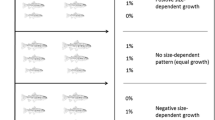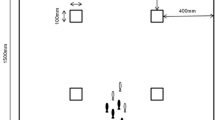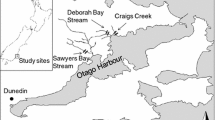Abstract
Group membership can confer both advantages and disadvantages to growth in juvenile fishes. The balance between costs and benefits of social interactions can shift depending on such factors as the composition of the group (density and size disparity) and the availability of food. We examined the effect of these factors on absolute growth and growth depensation in juvenile sablefish, Anoplopoma fimbria. Increasing density and increasing size disparity had little influence on absolute growth rates of juvenile sablefish and the effects of these social factors were not modified by ration level. In experiments testing density effects, absolute growth did not differ among groups of 1, 3, or 10 fish held at high rations, but at low rations single fish exhibited a different pattern of size-dependent growth compared to fish in groups. In experiments testing disparity effects, absolute growth did not differ between groups with an even size distribution and groups with a mixed size distribution. The relative size of an individual within a group, i.e., small, medium, or large, also did not modify growth, despite evidence of higher chasing behavior in mixed size distributions. Although the growth of small fish was not diminished in the presence of large fish, negative impacts of size disparity were expressed in high levels of cannibalism, which occurred in 42% of groups with a mixed size distribution. Significant growth depensation over time occurred in the density experiment, but not in the size disparity experiment, possibly due to the shorter duration of the latter experiment. We suggest that growth depensation was generated by individual variability in growth capacity rather than social effects on growth rates. Schooling behavior, measured by group cohesion indices, increased with fish size and was higher in groups with an even vs. a mixed size distribution. These results for sablefish are consistent with other schooling species in which growth variability is determined by exploitative competition and/or genetic variability in growth capacity rather than interference competition.
Similar content being viewed by others
References cited
Boehlert, G.W. & M.M. Yoklavich. 1985. Larval and juvenile growth of sablefish, Anoplopoma fimbria, as determined from otolith increments. U.S. Fish. Bull. 83: 475-481.
Boujard, T., M. Jourdan, M. Kentouri & P. Divanach. 1996. Diel feeding activity and the effect of time-restricted self-feeding on growth and feed conversion in European sea bass. Aquaculture 139: 117-127.
Carter, C.G., C.J. Purser, D.F. Houlihan & P. Thomas. 1996. The effect of decreased ration on feeding hierarchies in groups of greenback flounder (Rhombosolea tapirina: Teleostei). J. Mar. Biol. Ass. U.K. 76: 505-516.
Clark, C.W. & M. Mangel. 1986. The evolutionary advantages of group foraging. Theor. Pop. Biol. 30: 45-75.
Clark, P.J. & F.C. Evans. 1954. Distance to nearest neighbor as a measure of spatial relationships in populations. Ecology 35: 445-453.
Cui, Y. & R.J. Wootton. 1989. Grouping fails to affect the growth and energy budget of a cyprinid, Phoxinus phoxinus(L.). J. Fish Biol. 35: 795-798.
Davis, M.W. & B.L. Olla. 1987. Aggression and variation in growth of chum salmon (Oncorhynchus keta) juveniles in seawater: effects of limited rations. Can. J. Fish. Aquat. Sci. 44: 192-197.
Delco, E.A. & R.J. Byers. 1963. Reduced metabolic rates of two cyprinid fishes. Copeia 1963: 176-178.
Dong, Q. & D.L. DeAngelis. 1998. Consequences of cannibalism and competition for food in a smallmouth bass population: an individual-based modeling study. Trans. Amer. Fish. Soc. 127: 174-191.
Eggers, D.M. 1976. Theoretical effect of schooling by planktivorous fish predators on rate of prey consumption. J. Fish. Res. Board Can. 33: 1964-1971.
Eklöv, P. 1992. Group foraging versus solitary foraging efficiency in piscivorous predators: the perch, Perca fluviatilis, and pike, Esox lucius, patterns. Anim. Behav. 44: 313-326.
Folkvord, A. & H. Otterå. 1993. Effects of initial size distribution, day length, and feeding frequency on growth, survival, and cannibalism in juvenile Atlantic cod (Gadus morhuaL.). Aquaculture 114: 243-260.
Grover, J.J. & B.L. Olla. 1987. Effects of an El Niño event on the food habits of larval sablefish, Anoplopoma fimbria, off Oregon and Washington. U.S. Fish. Bull. 85: 71-79.
Houde, E.D. 1975. Effects of stocking density and food density on survival, growth and yield of laboratory-reared larvae of sea bream Archosargus rhomboidalis(L.) (Sparidae). J. Fish Biol. 7: 115-127.
Imsland, A.K., T. Nilsen & A. Folkvord. 1998. Stochastic simulation of size variation in turbot: possible causes analysed with an individual-based model. J. Fish Biol. 53: 237-258.
Jobling, M. 1985. Physiological and social constraints on growth of fish with special reference to Arctic charr, Salvelinus alpinusL. Aquaculture 44: 83-90.
Jobling, M. & B.M. Baardvik. 1994. The influence of environmental manipulations on inter-and intra-individual variation in food acquisition and growth performance of Arctic charr, Salvelinus alpinus. J. Fish Biol. 44: 1069-1087.
Jobling, M., J. Koskela & S. Winberg. 1999. Feeding and growth of whitefish fed restricted and abundant rations: influences on growth heterogeneity and brain serotonergic activity. J. Fish Biol. 54: 437-449.
Jobling, M. & T.-G. Reinsnes. 1986. Physiological and social constraints on growth of Arctic charr, Salvelinus alpinusL.: an investigation of factors leading to stunting. J. Fish Biol. 28: 379-384.
Kanda, T. & Y. Itazawa. 1978. Group effects on physiological and ecological phenomena in fish-II. Group effect on the growth of the medaka. Bull. Japan. Soc. Sci. Fish. 44: 1197-1200.
Kawanabe, H. 1969. The significance of social structure in production of the 'ayu', Plecoglossus altivelis. pp. 243-251. In: T.G. Northcote (ed.) Symposium on Salmon and Trout in Streams, H.R. MacMillan Lectures in Fisheries, University of British Columbia Institute of Fisheries, Vancouver.
Koebele, B.P. 1985. Growth and the size hierarchy effect: an experimental assessment of three proposed mechanisms; activity differences, disproportional food acquisition, physiological stress. Env. Biol. Fish. 12: 181-188.
Laidig, T.E., P.B. Adams & W.M. Samiere. 1997. Feeding habits of sablefish, Anoplopoma fimbria, off the coast of Oregon and California. NOAA Tech. Rep. NMFS 130: 65-79.
Li, H.W. & R.W. Brocksen. 1977. Approaches to the analysis of energetic costs of intraspecific competition for space by rainbow trout (Salmo gairdneri). J. Fish Biol. 11: 329-341.
Magnuson, J.J. 1962. An analysis of aggressive behavior, growth, and competition for food and space in medaka (Oryzias latipes(Pisces, Cyprinodontidae)). Can. J. Zool. 40: 313-363.
Magurran, A.E. & T.J. Pitcher. 1983. Foraging, timidity and shoal size in minnows and goldfish. Behav. Ecol. Sociobiol. 12: 147-152.
McCarthy, I.D., C.G. Carter & D.F. Houlihan. 1992. The effect of feeding hierarchy on individual variability in daily feeding of rainbow trout, Oncorhynchus mykiss(Walbaum). J. Fish Biol. 41: 257-263.
Metcalfe, N.B., F.A. Huntingford, W.D. Graham & J.E. Thorpe. 1989. Early social status and the development of life-history strategies in Atlantic salmon. Proc. R. Soc. Lond. B 236: 7-19.
Nijaguna, G.M., S.R. Reddy & K. Shakuntala. 1986. Combined effects of feeding frequency and population density on the food utilization of Poecilia reticulata(Peters). Pol. Arch. Hydrobiol. 33: 221-228.
Olla, B.L., M.W. Davis & C.H. Ryer. 1998. Understanding how the hatchery environment represses or promotes the development of behavioral survival skills. Bull. Mar. Sci. 62: 531-550.
Olla, B.L. & C. Samet. 1974. Fish-to-fish attraction and the facilitation of feeding behavior as mediated by visual stimuli in striped mullet, Mugil cephalus. J. Fish. Res. Board Can. 31: 1621-1630.
Parker, F.R., Jr. 1973. Reduced metabolic rates in fishes as a result of induced schooling. Trans. Amer. Fish. Soc. 102: 125-131.
Peuhkuri, N., E. Ranta, S.-K. Juvonen & K. Lindstrom. 1995. Schooling affects growth in the three-spined stickleback, Gasterosteus aculeatus. J. Fish Biol. 46: 221-226.
Peuhkuri, N., E. Ranta & P. Seppa. 1997. Size-assortative schooling in free-ranging sticklebacks. Ethology 103: 318-324.
Pitcher, T.J. & J.K. Parrish. 1993. Functions of shoaling behaviour in teleosts. pp. 363-439. In: T.J. Pitcher (ed.) Behaviour of Teleost Fishes, Chapman & Hall, London.
Pitcher, T.J., A.E. Magurran & I.J. Winfield. 1982. Fish in larger shoals find food faster. Behav. Ecol. Sociobiol. 10: 149-151.
Post, J.R., M.R.S. Johannes & D.J. McQueen. 1997. Evidence of density-dependent cohort splitting in age-0 yellowperch (Perca flavescens): potential behavioural mechanisms and population-level consequences. Can. J. Fish. Aquat. Sci. 54: 867-875.
Purdom, C.E., A. Jones & R.F. Lincoln. 1972. Cultivation trials with turbot (Scophthalmus maximus). Aquaculture 1: 213-230.
Ranta, E. & V. Kaitala. 1991. School size affects individual feeding success in three-spined sticklebacks (Gasterosteus aculeatusL.). J. Fish Biol. 39: 733-737.
Rubenstein, D.I. 1981. Individual variation and competition in the Everglades pygmy sunfish. J. Anim. Ecol. 50: 337-350.
Ryer, C.H. & B.L. Olla. 1995. The influence of food distribution upon the development of aggressive and competitive behaviour in juvenile chum salmon, Oncorhynchus keta. J. Fish Biol. 46: 264-272.
Ryer, C.H. & B.L. Olla. 1996. Growth depensation and aggression in laboratory reared coho salmon: the effect of food distribution and ration size. J. Fish Biol. 48: 686-694.
Ryer, C.H. & B.L. Olla. 1997. Altered search speed and growth: social versus independent foraging in two pelagic juvenile fishes. Mar. Ecol. Prog. Ser. 153: 273-281.
Sampath, K. & T.J. Pandian. 1985. Effects of size hierarchy on surface behaviour and conversion rate in an air-breathing fish Channa striatus. Physiol. Behav. 34: 51-55.
Shenker, J.M. 1988. Oceanographic associations of neustonic larval and juvenile fishes and dungeness crab megalopae off Oregon. U.S. Fish. Bull. 86: 299-317.
Shenker, J.M. & B.L. Olla. 1986. Laboratory feeding and growth of juvenile sablefish, Anoplopoma fimbria. Can. J. Fish. Aquat. Sci. 43: 930-937.
Smith, H.T., C.B. Schreck & D.E. Maughan. 1978. Effect of population density and feeding rate on the fathead minnow (Pimephales promelas). J. Fish Biol. 12: 449-455.
Sogard, S.M. & B.L. Olla. 1994. The potential for intracohort cannibalism in age-0 walleye pollock, Theragra chalcogramma, as determined under laboratory conditions. Env. Biol. Fish. 39: 183-190.
Sogard, S.M. & B.L. Olla. 1998. Behavior of juvenile sablefish, Anoplopoma fimbria(Pallas), in a thermal gradient: balancing food and temperature requirements. J. Exp. Mar. Biol. Ecol. 222: 43-58.
Sokal, R.R. & F.J. Rohlf. 1981. Biometry, 2nd edition. W.H. Freeman Co., New York. 859 pp.
Stirling, H.P. 1977. Growth, food utilization and effect of social interaction in the European bass Dicentrarchus labrax. Mar. Biol. 40: 173-184.
Valerio, M. & G.W. Barlow. 1986. Ontogeny of young Midas cichlids: a study of feeding, filial cannibalism and agonism in relation to differences in size. Biol. Behav. 11: 16-35.
Wankowski, J.W.J. & J.E. Thorpe. 1979. Spatial distribution and feeding in Atlantic salmon, Salmo salarL., juveniles. J. Fish Biol. 14: 239-247.
Yamagishi, H. 1969. Postembryonal growth and its variability of the three marine fishes with special reference to the mechanism of growth variation in fishes. Res. Popul. Ecol. (Kyoto) 11: 14-33.
Author information
Authors and Affiliations
Rights and permissions
About this article
Cite this article
Sogard, S.M., Olla, B.L. Effects of Group Membership and Size Distribution within a Group on Growth Rates of Juvenile Sablefish Anoplopoma fimbria. Environmental Biology of Fishes 59, 199–209 (2000). https://doi.org/10.1023/A:1007659903444
Issue Date:
DOI: https://doi.org/10.1023/A:1007659903444




